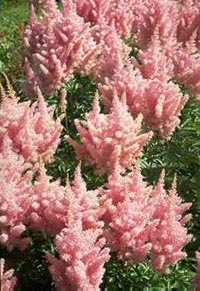Resource Library
Plant of the Week: Astilbe
The University of Arkansas System Division of Agriculture does not promote, support or recommend plants featured in "Plant of the Week." Please consult your local Extension office for plants suitable for your region.
Plant of the Week
Astilbe
Latin: Astilbe x arendsii

Shady gardens are the norm in Arkansas. These same shade trees that make our summers bearable challenge the gardener to provide effective summer display when the trees are fully leafed and the water demand is at its greatest.
Astilbes, native to mountain ravines of China and Japan, can provide a solution for the gardener seeking a summer flowering perennial with graceful form and handsome foliage.
Astilbes are clump forming perennials that belong to the saxifrage family and arise from a stout rootstock. The dark green, shimmering leaves are compound and produced on the many upright stems that can grow from one- to four feet tall, depending on the selection. Flowers are feathery plumes extending above the foliage in shades of pink, red or white and appear in late spring and early summer. A few selections are even fall flowering.
Astilbes have been grown in gardens since the early years of the last century when plant explorers such as Carl Peter Thunberg and Robert Fortune visited their homelands.
While the wild species were grown by specialist nurseries, they were not frequently encountered. It was not until the first part of this century that they became commonplace in the nursery trade. The man responsible for the popularization of the plant was George Arends, a nurseryman from Ronsdorf, Germany. Arends Nursery, today being run by his granddaughter, has produced most of the hybrid astilbes in the marketplace today. Arends used four species in most of his crosses, Astilbe japonica, A. thunbergii, A. astilboides, and A. chinensis.
Some of Arend’s most popular introductions are "Amethyst" (lavender pink 24 - 30 inches, midseason), "Bridal Veil" (white, 18 - 24 inches, early), "Cattleya" (rose purple, 36 inches, midseason), "Deutschland" (white, 24 inches, early) and "Venus" (pink, 36 inches, late).
Almost every hybrid astilbe can be traced directly or indirectly back to Arends. In the early years of this century, most people knew astilbes as a winter blooming pot plant, not as the stately garden perennial we know today.
Astilbes are useful additions to the summer border or for massing in the shaded garden. They should have a fertile, well watered soil rich in organic matter. While they will grow in full sun in the north, in most of the southern United States, they benefit from shade from mid afternoon onward.
Regardless of where astilbes are grown, they have a high water demand. Plants that are stressed for water will have burned summer foliage and disappear in a season or two. Plants receiving adequate summer moisture and situated in a fertile soil will form large clumps and should be divided every three or four years.
By: Gerald Klingaman, retired
Extension Horticulturist - Ornamentals
Extension News - May 21, 1999
The University of Arkansas System Division of Agriculture does not maintain lists of retail outlets where these plants can be purchased. Please check your local nursery or other retail outlets to ask about the availability of these plants for your growing area.